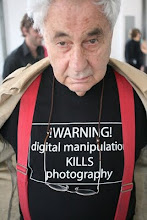 PHOTO-EYE BOOKLIST EDITOR'S CHOICE by DARIUS HIMES
PHOTO-EYE BOOKLIST EDITOR'S CHOICE by DARIUS HIMESI’VE ALWAYS HAD A THING FOR SMALL BOOKS. Reading a book is an intimate and very tactile experience and a small book plays into that feeling. In general, however, art and photobooks are larger than your average book of literature, which makes reading them a different experience altogether.
Another attraction of mine is books in a set or series. The world of literature is full of brilliant series: the Everyman’s Library by Knopf and most Penguin’s Great Ideas series immediately come to mind.
It is therefore a distinct pleasure to come across photobooks that, in size at least, are akin to their literary cousins. Several running feet of my shelf space at home are dedicated to photobooks that are either a smaller trim size than average or quite thin, hovering around two or three signatures at most. And it is doubly thrilling to come across a publisher that is exploring the world of photography through a series of small books.
A handful of publishers are currently doing just that. Both Phaidon and Thames & Hudson—two of Europe’s most well known and well established art book houses—have, in recent years, tested the market with series of small, traditional biographical monographs on important historical and contemporary photographers. In America the most notable example is the exquisite One Picture Book series, by Nazraeli Press. Each of the books in these series is an engaging and considered object, with a small, coherent body of work forming the core.
What the small book format provides for a photographer is a chance to explore a limited body of work or a singular idea that falls outside the scope of their larger bodies of work. Or, in the curious case of Dutch photographer Paul Kooiker, it really lets you encapsulate an obsession. Seminar is the third book in an unnamed series from Kooiker published by Amsterdam-based Van Zoetendaal. The other two titles are Hunting and Fishing and Showground.
Each of the books perfectly reveals an idée fixe—Seminar is filled with cropped and grainy photographs of a woman’s feet clad in modest but sexy black, French court shoes with kitten heels and a bow and eyelet in the back. Every image has the appearance of being surreptitiously snapped by a seminarstalker, as it were—we catch glimpses of the woman taking notes and sitting in the audience in a folding metal chair. Kooiker has given every image in the book a pink overwash, which only serves to overemphasize the femininity of the work.
The effect is thoroughly engrossing (it also helps to be attracted to heels) and much like reading a short story. In this case, all three of Kooiker’s titles seem to embody the effect that Lewis Baltz has stated so clearly: “It might be more useful, if not necessarily true, to think of photography as a narrow, deep area between the novel and film.”

Seminar, thematisering van het voyeurisme
Fotografen en beeldend kunstenaars zijn uit de aard van hun professie kijkers. Zij zien beelden, denken in beelden en uiten zich in beelden. Wanneer zij hun medemens bezien vanuit hun persoonlijke interesse raken zij aan het fenomeen dat voyeurisme genoemd wordt. Paul Kooiker onderzoekt dit fenomeen.
Seminar, het meest recente uit een reeks publicaties van Kooiker bij uitgeverij Basalt/Van Zoetendaal Publishers, is een pure verbeelding van het verhaal van de jagende fotograaf en diens prooi, het in de regel onwetende model.
Paul Kooiker (Rotterdam 1964) werkt in Amsterdam als fotograaf/beeldend kunstenaar en is tevens docent aan de Rietveldacademie. In 1996 won hij de eerste prijs bij de Prix de Rome fotografiecompetitie.
Vorig jaar bezocht hij een bijeenkomst over Nederlandse fotografie in Seoul, de hoofdstad van Korea, waar galeriehouder en uitgever Willem van Zoetendaal een tentoonstelling presenteerde.De fotograaf zal weinig van de discussie hebben meegekregen, want hij heeft zich volledig geconcentreerd op een Koreaanse medewerkster en dan met name op haar bijzondere schoeisel.
Seminar bevat 30 opnamen van een Aziatische jongedame in een donkere jurk. Zij draagt een paar donkere pumps met een ronde neus, waarvan vooral de achterkant opvallend is. In de hiel van de schoen is een ronde opening opgenomen met daarboven een strikje.
Het boekje bestaat uit een reeks beelden waarin het model en vooral haar benen en schoenen vanuit verschillende beeldhoeken zijn gefotografeerd. Het gezicht blijft buiten beeld of is door het gekozen standpunt onherkenbaar. Deze werkwijze is karakteristiek voor het oeuvre van Kooiker, die in zijn fotografie speelt met de glorie en de tragiek van het verzamelen en het voyeurisme.
De uitgave sluit aan bij de wegrennende nimfen in zijn boek Hunting and Fishing (1999) en de verzameling beelden van modellen en studio in Showground (2005).De vormgeving is even sober en eigenzinnig als bij deze eerdere publicaties en past weer uitstekend bij de bedoelingen van de fotograaf.
Han Schoonhoven































